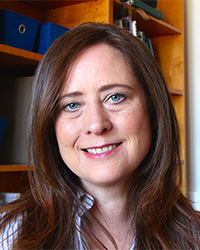
"The students particularly enjoyed labs and activities that combined data collection with mathematical analysis. Overall, the students were more interactive this semester, both in lecture and in labs / group activities.
Course: Introduction to Quantitative Biology
Department: Biology and Mathematics
Reflection:
One of the most successful elements of the course redesign was providing the students with very detailed learning objectives. This was particularly useful since mathematical skills are often not evaluated in a biology class, and this provided students with a checklist of skills they needed to develop. The students also particularly enjoyed labs and activities that combined data collection with mathematical analysis. Overall, the students were more interactive this semester, both in lecture and in labs / group activities. The assignments that required students to work together to collect data were the most interactive. I plan to add more activities like this in future semesters. Finally, I plan to develop more videos that review background material given the diversity of students in the course.
Course Description
This course targets biology majors who are interested in quantitative biology, mathematical modeling, and computer simulation. Mathematics, physics, chemistry, and computer science majors who are interested in biological applications of mathematics are also welcome to enroll. The major goals of the course are 1) to write down mathematical models to describe molecular, cellular, and organismal processes, 2) to solve the mathematical models numerically or analytically and evaluate them against experimental data, and 3) to become proficient in the use of MATLAB for biological applications, both in terms of writing programs and using software packages.
This is a mathematical modeling class for non-math majors, and the size is typically 24. The primary challenge in this course is that students have widely varying mathematics and computer programming abilities. Some of the students have never taken a college mathematics course (if they placed out of MATH 231) while others are math/biology double majors. Some students are proficient in one or more programming languages, while others have not yet written a computer program. The students’ interest in applying mathematics to biology is also widely varying.
More specifically, there are challenges getting the students to work in groups given the range of backgrounds. Students can find it intimidating to ask questions and discuss ideas because they do not want to look bad to their peers. It is also somewhat challenging to get more advanced students to assist beginning students with coding. We code together in various class activities, and it can be difficult for me to provide everyone with the individual attention they need. It is also challenging to lead students through longer mathematical calculations since they can quickly become lost in the details and forget the point of the exercise.
This class attracts undergraduates from all years and many STEM majors. There are some successes each where in which students become q-bio majors and pursue research in quantitative biology. There are other students who struggle with the mathematics and programming activities and are not getting as much as they could out of the class. I have taught this course for three years prior to this semester.
Students are expected to review assigned readings, lecture notes, and other materials posted on webassign before each class. Comprehension of the material covered in lectures is evaluated from in-class assignments and homeworks that involve writing down mathematical models, solving them numerically or analytically, and evaluating them against experimental data. All assignments are provided online through webassign.net.
Projected Design Elements
-Active engagement strategies
-The use of case studies
-The use of videos (both in-class and as assigned viewing)
-Clearly defined learning objectives
Incorporated Design Elements
-Group Activities
-Case Studies
-Videos (both in-class and as assigned viewing)
-Think-Pair-Share
-Computing Activities with Comparison to Data the Students Collect
-Clearly Defined Learning Objectives
Program: Finish Line Project




